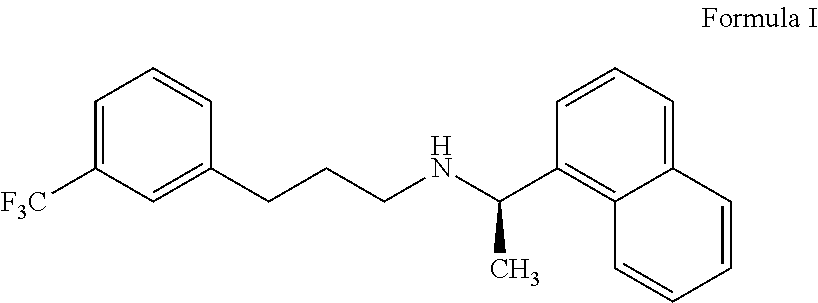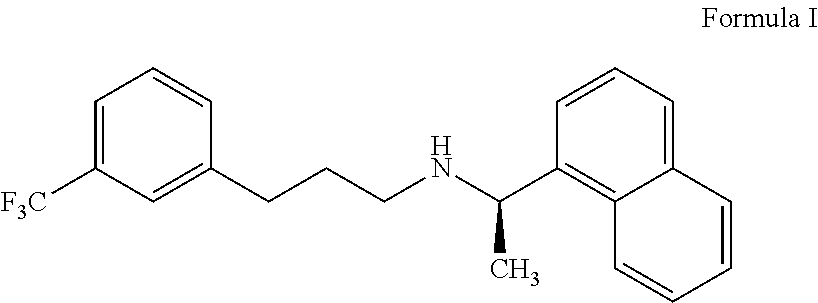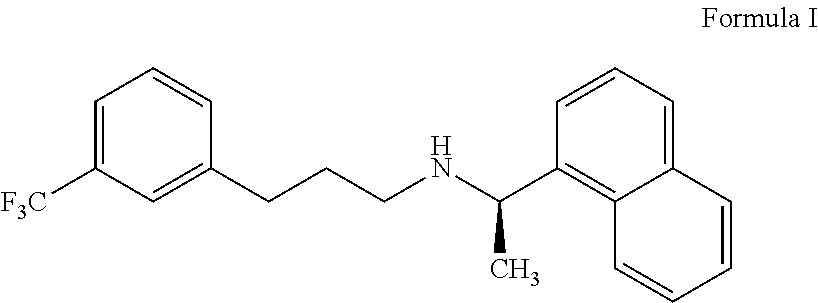Process for preparing cinacalcet and pharmaceutically acceptable salts thereof
a technology of cinacalcet and salt, which is applied in the preparation of carbamic acid derivatives, organic compound preparations, organic chemistry, etc., can solve the problems of increasing the risk of renal bone disease, soft tissue calcification and vascular disease, and not providing any example for the preparation of cinacalcet and its pharmaceutically acceptable salt, etc., and achieves the effect of efficient us
- Summary
- Abstract
- Description
- Claims
- Application Information
AI Technical Summary
Benefits of technology
Problems solved by technology
Method used
Image
Examples
example 1
Preparation of 3-(3-trifluoromethyl-phenyl)-propan-1-ol
Method A: To a solution of 3-(3-trifluoromethyl-phenyl)-propionic acid (5 g, 0.023 mol) in tetrahydrofuran (25 ml) was added borane-dimethylsufide (1.74 g, 0.023 mol) and refluxed for 2 hours. Reaction mixture was cooled and methanol (10 ml) was added at 5-10° C. Solvents were distilled off followed by addition of isopropylether (25 ml) and 5N hydrochloric acid (20 ml). The reaction mixture was heated at 45-50° C. for 2 hours and then cooled to 25-30° C. The layers were separated; organic layer was washed with water, dried and evaporated to give 4.11 g of the title compound.
Method B: A solution of 3-(3-trifluoromethyl-phenyl)-propionic acid (300 g, 1.375 mol) in toluene (1.5 L) was azeotroped for 1 hour and cooled to 40-45° C. Thereafter, borane-dimethylsufide (126.52 g, 1.67 mol) was added and reaction mixture was heated for 3-4 hours at 85° C. and cooled to 0-5° C. The reaction mixture was quenched with methanol (900 ml) and s...
example 2
Preparation of toluene-4-sulfonic acid 3-(3-trifluoromethyl-phenyl)-propyl ester
p-Toluenesulfonyl chloride (11.21 g, 0.0588 mol) was added to a solution of 3-(3-trifluoromethyl-phenyl)-propan-1-ol (10 g, 0.049 mol), triethylamine (9.0 ml, 0.06468 mol), 4-N,N-dimethylaminopyridine (0.66 g, 0.0054 mol) in dichloromethane (50 ml) at 25-30° C. The reaction mixture was stirred at a temperature of 35-40° C. for 15 hours. Thereafter, the layers were separated and dichloromethane layer was washed with water (2×20 ml) and dried over anhydrous sodium sulphate. Solvent was distilled off to give 15 g of title compound.
example 3
Preparation of toluene-4-sulfonic acid 3-(3-trifluoromethyl-phenyl)-propyl ester
To a stirred solution of p-toluenesulfonyl chloride (360 g, 1.89 mol) in dichloromethane (1.0 L), triethylamine (243 g, 2.4 mol) and 4-N,N-dimethyl amino pyridine (21 g, 0.17 mol) was added. Thereafter, the reaction mixture was cooled to 0° to −5° C. followed by addition of 3-(3-trifluoromethyl-phenyl)-propan-1-ol (350 g, 1.714 mol) and maintained at 0 to 10° C. temperature for 3 hours. Water (1.05 L) was added to the reaction mixture and stirred for 15 minutes. Layers were separated and washed sequentially with sodium carbonate (1.05 L, 10%), hydrochloric acid (1.05 L, 1N) and water (1.05 L). The organic layer was dried over anhydrous sodium sulphate and was distilled off under vacuum at 25-30° C. to give 522 g of title compound having purity 97.67% by HPLC.
PUM
| Property | Measurement | Unit |
|---|---|---|
| Fraction | aaaaa | aaaaa |
| Structure | aaaaa | aaaaa |
| Area | aaaaa | aaaaa |
Abstract
Description
Claims
Application Information
 Login to View More
Login to View More - R&D
- Intellectual Property
- Life Sciences
- Materials
- Tech Scout
- Unparalleled Data Quality
- Higher Quality Content
- 60% Fewer Hallucinations
Browse by: Latest US Patents, China's latest patents, Technical Efficacy Thesaurus, Application Domain, Technology Topic, Popular Technical Reports.
© 2025 PatSnap. All rights reserved.Legal|Privacy policy|Modern Slavery Act Transparency Statement|Sitemap|About US| Contact US: help@patsnap.com



